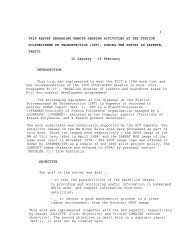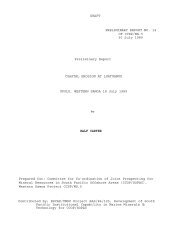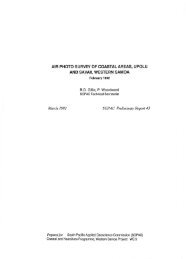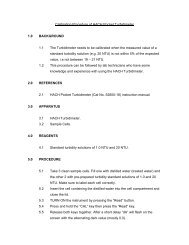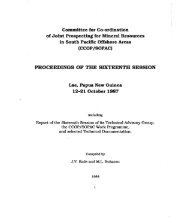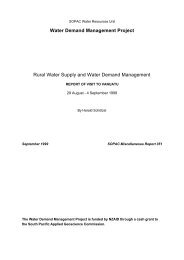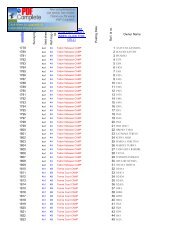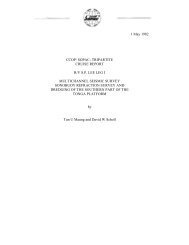Coastal engineering design of a rip-rap revetment ... - Up To - SOPAC
Coastal engineering design of a rip-rap revetment ... - Up To - SOPAC
Coastal engineering design of a rip-rap revetment ... - Up To - SOPAC
You also want an ePaper? Increase the reach of your titles
YUMPU automatically turns print PDFs into web optimized ePapers that Google loves.
<strong>Coastal</strong> Engineering Design, Yaren District, Republic <strong>of</strong> Nauru<br />
Table. 1. Preliminary <strong>rip</strong>-<strong>rap</strong> <strong>design</strong> guidelines.<br />
RIP-RAP REVETMENT FOR YAREN COASTLINE, REPUBLIC OF NAURU<br />
For:<br />
1. Significant wave height, Hs, Plunging Breakers 3.0 m<br />
2. Significant wave period, Ts 6 seconds<br />
3. Angle <strong>of</strong> incidence <strong>of</strong> wave approaching the shoreline 015 degrees<br />
4. Density <strong>of</strong> seawater 1025 kg/cubic metre<br />
5. Density <strong>of</strong> cavernous re-crystallised limestone, from Nauru 2500 kg/cubic metre<br />
Use and Prescribe:<br />
1. Diameter <strong>of</strong> stones required, D50 1.04 m<br />
2. Nominal diameter <strong>of</strong> stones, Dn50 0.89 m<br />
3. Required weight <strong>of</strong> stones, W50 1745 kg<br />
1. These stones form the outer layer/primary armour and the toe <strong>of</strong> the <strong>rip</strong> <strong>rap</strong> <strong>revetment</strong>.<br />
2. Use two (2) layers <strong>of</strong> these larger boulders/rocks, each placed separately to ensure proper packing and interlocking.<br />
3. Each <strong>of</strong> the outer layer (with large rocks) should have a thickness <strong>of</strong> 2 x Diameter <strong>of</strong> the rock required (1.04 m): approximately 2 m X 2 layers.<br />
4. Underlying the primary armour, there should be smaller rocks, grading to smaller boulders and finally into the edge <strong>of</strong> the land.<br />
5. These smaller rocks should be between 0.50-0.70 m in diameter, above a layer <strong>of</strong> boulders 0.20-0.35 m in diameter.<br />
6. Therefore, we envisage four (4) main aggregate layers.<br />
7. A double outer layer with 1.04-m boulders, over a layer with 0.5-0.7-m boulders, over an inner layer <strong>of</strong> 0.2-0.35-m boulders.<br />
8. The interface <strong>of</strong> the primary armour and the underlying 0.5-0.7-m boulders should be a geotextile filter fabric.<br />
9. A similar geotextile fabric layer should be placed between the 0.50-0.70-m boulders and the underlying 0.20-0.35-m boulders.<br />
10. The rock layering and geotextile fabric will minimise scouring due to wave run-up, between the boulders and within layers.<br />
<strong>SOPAC</strong> Preliminary Report 124, October 2000: Russell J. Maharaj<br />
46



